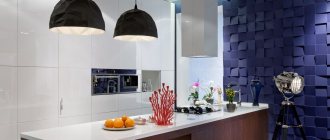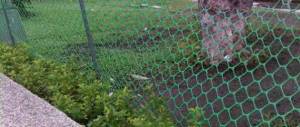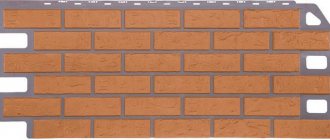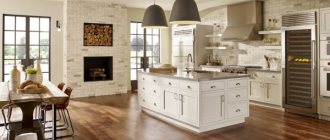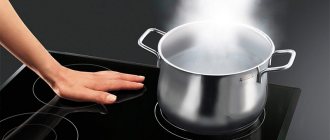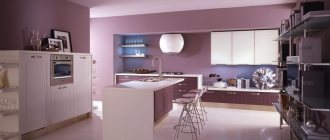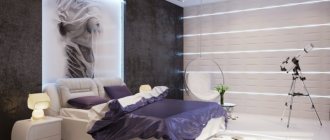Using plastic you can equip any type of kitchen surface. The universal material allows you to finish walls, ceilings, aprons, having high performance properties and allowing you to decorate the interior in any stylistic direction.
Competent kitchen finishing with plastic panels
The smooth surface of the material with a dense structure makes it possible to use the products for a wide range of works. Durable, heat-stable plastic panels are installed on a wooden sheathing, fastened with a groove joint.
There is a wide variety of textures for wall panels, providing the opportunity to imitate varnished or painted wood, stone, metal, plaster, and marble. The operational advantages of the material can be considered: 1) the possibility of long-term use without compromising the appearance; 2) increased moisture resistance and strength; 3) installation on any types of uneven surfaces; 4) resistance to various mechanical damage; 5) high noise and sound insulation characteristics.
PVC panels are environmentally friendly and do not emit any harmful substances into the atmosphere. If necessary, using original ready-made materials, you can veil electrical wiring, pipes, overhead communications.
Practical ceiling made of plastic panels in the kitchen
Materials for arranging any kitchen surfaces must be resistant to mechanical damage, high humidity and temperature changes. For this reason, suspended plastic ceilings have been considered one of the most popular finishing options for many years.
No less worthy qualities of the material are the low cost of products, environmental friendliness, and durability. Fungus or mold does not appear on plastic panels. The original appearance helps to embody the most daring design ideas. When choosing modern panels in the form of lining in stripes, you can mount spotlights, creating a fashionable, fresh design.
Why is plastic so good?
Everyone knows that plastic products are quite cheap. It's all about the production method and raw materials. But for us, as consumers, this is only to our advantage. After all, with excellent characteristics, you get affordable kitchen finishing material. And repairs are a costly business, so every penny can count. The price-to-practicality ratio of PVC panels is simply excellent.
Here are all the advantages that plastic has:
- Light weight. The finishing will not load the structure, and working with the panels is simplified.
- The material is absolutely not afraid of water. It is not afraid of rooms with high humidity and wet cleaning. The kitchen is a place where dirt and moisture are something familiar. If moisture gets on the surface, it will not be absorbed, but will simply dry out. And to clean the contaminated surface, wipe the facade with a damp cloth.
- Long service life. Having finished your kitchen once, you can forget about changing the decoration in the next 10 years.
- The products do not rot and do not conduct current. Gone are the days when all processes in the kitchen were performed using only your hands. Today, electrical appliances come to the aid of housewives. Sometimes it happens that the wiring may deteriorate and a short circuit may occur due to overload. But plastic will not conduct current.
- Easy to install. You can install plastic panels yourself without spending a lot of time and effort. Even if you are not a master, detailed instructions will help you decorate the facade with your own hands.
- The appearance is quite attractive. The kitchen will be made the way you want. The material will not limit you to this. After all, the range of goods is quite large.
- The material is not afraid of temperature changes.
There are really many advantages, and this despite the fact that the price of the material is low. In this regard, the shortcomings that the material has seem negligible. The main one is high flammability. If a fire source is opened, the material will quickly ignite.
Advice! Buy PVC panels that can withstand temperatures of 170 degrees.
I would also like to note the insufficient strength of the material. With a strong point impact, you can break the surface. The damaged piece will need to be replaced. And if you buy low-quality material, then over time it will fade in the sun.
Now that you know everything about plastic panels, let's look at the installation technology. Thanks to her, you can do the kitchen tiling yourself.
Colorful plastic panel for the kitchen - an apron for a bright design
Every kitchen, regardless of equipment, has free surfaces that are most susceptible to contamination. Such areas can be located between the sink, stove, floor or wall cabinets, and modern household appliances. To protect the walls in these spaces, it is customary to install special structures - aprons.
Popular products are plastic panels used to decorate kitchen splashbacks. Main advantages: • Increased resistance to the negative effects of moisture. • Absence of deformation processes under various conditions. • Ease of installation of structures and subsequent maintenance. • Ability to withstand high temperatures. • Low specific gravity, which does not create an increased load on the walls.
Kitchen aprons can fit into any interior. This is facilitated by the possibility of applying any colors and images to the surface. Using modern photo printing techniques, you can transfer photographs, paintings, and decorative elements onto plastic aprons.
Main characteristics
If your choice fell on decorative kitchen panels, then you should first of all become familiar with their types.
The main materials for the manufacture of wall panels are
- plastic,
- wooden slabs,
- glass.
Glass wall panels are also called skinali. Glass skins are leaders in the number of panels purchased, even surpassing plastic. And this despite the fact that they appeared quite recently. But over the course of several years they have shown the level of their demand.
Glass wall panel. They threw it off.
They are made from special tempered glass with a thickness of slightly more than 4 mm. Such material, oddly enough, can withstand almost any mechanical load, and high temperatures are not dangerous for them. The same applies to various detergents.
The surface of the glass panels is completely smooth, so when caring for them, you just need to wipe them with a damp cloth. Glass is easily washed from grease (which cannot be said about tiles, paint or wood). But in the process of cooking in the kitchen, such contamination is simply inevitable!
Remember that water stains are visible on the glossy glass surface, so wipe them regularly or immediately buy panels with a matte finish.
Example of glass wall covering for the kitchen
When caring for glass panels, you can use any household products, except those that contain abrasives. These include metal mesh and fairly stiff brushes. Under no circumstances should such surfaces be exposed to flame! Remember that the distance between the stove (more precisely, the gas burner) and the glass panel must be at least 7 cm.
If the glass panels do overheat (this is possible at temperatures above 90 degrees Celsius), the pattern on the glass or even the glass itself may be damaged.
Wooden panels are by far the most expensive. In their manufacture, different types of wood are used - alder, oak, cedar, etc. These are suitable for offices, living quarters or corridors. If you decide to install these in the kitchen, they must be treated with special products that prevent the wood from swelling under the influence of excessive humidity.
Wood panel option
Wooden panels are made from wood materials (fibreboard and chipboard) or from MDF. At the same time, chipboard panels are very fragile; under no circumstances should they be placed in the kitchen, since they are susceptible to the harmful effects of sudden temperature changes. High humidity also negatively affects wood panels, and such humidity is common in kitchens. MDF, on the contrary, can withstand heavy loads and is not afraid of moisture. Moreover, such material is easy to maintain and install.
MDF wall covering
Plastic sheet panels are made from solid polyvinyl chloride. This is a high-quality and safe material that is very easy to care for, lightweight, and also wear-resistant and durable. Its pleasant difference is its affordable price for every family. PVC sheet panels are made in a variety of colors and can imitate brick, mosaic or even stone. We recommend paying special attention to plastic, because this material is the best option for kitchen panels based on a combination of factors.
Plastic wall covering in the kitchen
The plastic panels contain a minimal amount of softener. This makes it very durable; it is resistant to both moisture and fire, unlike glass. It is also worth adding that plastic panels have a voluminous internal space, which provides such unique properties as thermal insulation and sound insulation.
Plastic panels are exactly what will allow you to transform the interior of your kitchen. The finish with photo printing looks especially impressive.
PVC sheet panels in the kitchen
And yet we should not forget that such a material is quite unstable to various mechanical influences. This is almost the only significant drawback of plastic wall panels. It is not recommended to place plastic close to the stove, where temperatures tend to be high. Also, never use substances that contain abrasives when caring for plastic surfaces.
Kitchen design with plastic panels
Modern variations of finishing materials provide kitchen spaces with the necessary qualities, giving comfort, elegance, and pretentiousness. Among a wide variety of plastic panels, you can choose products with imitation of natural materials. Depending on the type of design and specific style, you can use various patterns, textures, and photo printing.
PVC panels are divided into separate categories according to the quality of the coating (matte or glossy), according to the types of joints (with seams or seamless), according to the methods of applying the pattern (film or printed). When choosing specific products, you need to focus on the area of the room, the lighting in the kitchen, the operational features of the material and operating conditions. The advantages that kitchen owners will receive will be: • Easy maintenance. You can wash or wipe the plastic using warm water or household chemicals. • Safety. The products are not conductors of electric current. • Ease of installation. Even if a segment fails, it can be replaced on its own. • Aesthetics. Imitation of any natural materials provides the possibility of use for beauty and decoration. • Variety. Depending on the end goal, you can choose a plain or colored coating, matte or glossy.
To design a small kitchen, you can use light PVC panels with vague patterns or images. For spacious rooms, the best option would be products with colorful designs and patterns.
Crazy hands: DIY plastic panels in the kitchen
Working with PVC panels is considered one of the simplest and most unobtrusive. Having selected and purchased plastic sheets, you need to prepare the remaining tools and materials: 1) for the frame - wooden slats or metal profiles; 2) construction stapler, special fasteners; 3) tape measure, small hacksaw, pencil, ruler, level.
For proper installation of corners and joints, you will need moldings - special plastic profiles. Installation begins from the corner of the room, creating a wooden or metal frame. Depending on how the panels will be positioned, the slats are mounted vertically or horizontally. The first panel is installed vertically, inserted into the corner profile with a side cut. The correct installation of this element will determine how smoothly all subsequent sheets will be installed.
You can, if necessary, change the direction of the masonry, ensuring proper zoning of the room. In some cases, wall panels can be laid with glue. In this case, the surface quality must be appropriate - it must be clean and perfectly flat.
Pros and cons of this type of finish
PVC panels are among the leading kitchen finishing materials. This position is ensured due to the following advantages:
- Water resistance. In the room where food is prepared, fumes are constantly present. Plastic panels do not change size and shape when exposed to water.
- Light-weight parts are simply attached to the sheathing or to the wall or ceiling using glue, without weighing down the base.
- Working with PVC is done “dry”, that is, the use of adhesive or cement solutions is not required, and there is no need to pre-prepare the surface. It is enough to make the sheathing and attach the cladding elements.
- Since plastic is easy to cut and easy to install, even in a large room the work takes several hours.
- A huge number of colors and textures of the PVC finishing coating makes it possible to choose what you need in terms of quality and design. They decorate not only the walls, but also the apron.
The resulting surface is flat, smooth, without noticeable seams. She is easy to care for. In this case, use ordinary rags and household detergents.
Advice. When purchasing material intended for kitchen finishing, you need to ask the seller for a quality certificate. Panels must have high resistance to thermal damage and abrasion. In addition, the document is a guarantee of environmental friendliness.
Among the disadvantages of PVC, consumers highlight:
- Susceptibility to mechanical damage. When hit, holes and cracks form on them.
- Possible damage due to high temperature. This should be taken into account when tiling the kitchen apron. The hob should not be installed too close to the wall.
Some options, often inexpensive slatted panels, lose their color brightness when exposed to sunlight and detergents.
